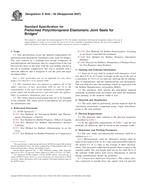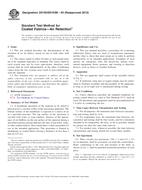Electronic circuits used in many space, military and nuclear power systems may be exposed to various levels of ionizing radiation dose. It is essential for the design and fabrication of such circuits that test methods be available that can determine the vulnerability or hardness (measure of nonvulnerability) of components to be used in such systems.
Manufacturers are currently selling semiconductor parts with guaranteed hardness ratings, and the military specification system is being expanded to cover hardness specification for parts. Therefore test methods and guides are required to standardize qualification testing.
Use of low energy (≈10 keV) X-ray sources has been examined as an alternative to cobalt-60 for the ionizing radiation effects testing of microelectronic devices (3, 4, 5, 6). The goal of this guide is to provide background information and guidance for such use where appropriate.
Note 3 – Cobalt-60-The most commonly used source of ionizing radiation for ionizing radiation (“total dose“) testing is cobalt-60. Gamma rays with energies of 1.17 and 1.33 MeV are the primary ionizing radiation emitted by cobalt-60. In exposures using cobalt-60 sources, test specimens must be enclosed in a lead-aluminum container to minimize dose-enhancement effects caused by low-energy scattered radiation (unless it has been demonstrated that these effects are negligible). For this lead-aluminum container, a minimum of 1.5 mm of lead surrounding an inner shield of 0.7 to 1.0 mm of aluminum is required. (See 8.2.2.2 and Practice E1249.)
The X-ray tester has proven to be a useful ionizing radiation effects testing tool because:
It offers a relatively high dose rate, in comparison to most cobalt-60 sources, thus offering reduced testing time.
The radiation is of sufficiently low energy that it can be readily collimated. As a result, it is possible to irradiate a single device on a wafer.
Radiation safety issues are more easily managed with an X-ray irradiator than with a cobalt-60 source. This is due both to the relatively low energy of the photons and due to the fact that the X-ray source can easily be turned off.
X-ray facilities are frequently less costly than comparable cobalt-60 facilities.
The principal radiation-induced effects discussed in this guide (energy deposition, absorbed-dose enhancement, electron-hole recombination) (see Appendix X1) will remain approximately the same when process changes are made to improve the performance of ionizing radiation hardness of a part that is being produced. This is the case as long as the thicknesses and compositions of the device layers are substantially unchanged. As a result of this insensitivity to process variables, a 10-keV X-ray tester is expected to be an excellent apparatus for process improvement and control.
Several published reports have indicated success in intercomparing X-ray and cobalt-60 gamma irradiations using corrections for dose enhancement and for electron-hole recombination. Other reports have indicated that the present understanding of the physical effects is not adequate to explain experimental results. As a result, it is not fully certain that the differences between the effects of X-ray and cobalt-60 gamma irradiation are adequately understood at this time. (See 8.2.1 and Appendix X2.) Because of this possible failure of understanding of the photon energy dependence of radiation effects, if a 10-keV X-ray tester is to be used for qualification testing or lot acceptance testing, it is recommended that such tests should be supported by cross checking with cobalt-60 gamma irradiations. For additional information on such comparison, see X2.2.4.
Because of the limited penetration of 10-keV photons, ionizing radiation effects testing must normally be performed on unpackaged devices (for example, at wafer level) or on unlidded devices.
^SCOPE:
1.1 This guide covers recommended procedures for the use of X-ray testers (that is, sources with a photon spectrum having ≈10 keV mean photon energy and ≈50 keV maximum energy) in testing semiconductor discrete devices and integrated circuits for effects from ionizing radiation.
1.2 The X-ray tester may be appropriate for investigating the susceptibility of wafer level or delidded microelectronic devices to ionizing radiation effects. It is not appropriate for investigating other radiation-induced effects such as single-event effects (SEE) or effects due to displacement damage.
1.3 This guide focuses on radiation effects in metal oxide semiconductor (MOS) circuit elements, either designed (as in MOS transistors) or parasitic (as in parasitic MOS elements in bipolar transistors).
1.4 Information is given about appropriate comparison of ionizing radiation hardness results obtained with an X-ray tester to those results obtained with cobalt-60 gamma irradiation. Several differences in radiation-induced effects caused by differences in the photon energies of the X-ray and cobalt-60 gamma sources are evaluated. Quantitative estimates of the magnitude of these differences in effects, and other factors that should be considered in setting up test protocols, are presented.
1.5 If a 10-keV X-ray tester is to be used for qualification testing or lot acceptance testing, it is recommended that such tests be supported by cross checking with cobalt-60 gamma irradiations.
1.6 Comparisons of ionizing radiation hardness results obtained with an X-ray tester with results obtained with a LINAC, with protons, etc. are outside the scope of this guide.
1.7 Current understanding of the differences between the physical effects caused by X-ray and cobalt-60 gamma irradiations is used to provide an estimate of the ratio (number-of-holes-cobalt-60)/(number-of-holes-X-ray). Several cases are defined where the differences in the effects caused by X-rays and cobalt-60 gammas are expected to be small. Other cases where the differences could potentially be as great as a factor of four are described.
1.8 It should be recognized that neither X-ray testers nor cobalt-60 gamma sources will provide, in general, an accurate simulation of a specified system radiation environment. The use of either test source will require extrapolation to the effects to be expected from the specified radiation environment. In this guide, we discuss the differences between X-ray tester and cobalt-60 gamma effects. This discussion should be useful as background to the problem of extrapolation to effects expected from a different radiation environment. However, the process of extrapolation to the expected real environment is treated elsewhere (1, 2).
1.9 The time scale of an X-ray irradiation and measurement may be much different than the irradiation time in the expected device application. Information on time-dependent effects is given.
1.10 Possible lateral spreading of the collimated X-ray beam beyond the desired irradiated region on a wafer is also discussed.
1.11 Information is given about recommended experimental methodology, dosimetry, and data interpretation.
1.12 Radiation testing of semiconductor devices may produce severe degradation of the electrical parameters of irradiated devices and should therefore be considered a destructive test.
1.13 The values stated in SI units are to be regarded as standard. No other units of measurement are included in this standard.
1.14 This standard does not purport to address all of the safety concerns, if any, associated with its use. It is the responsibility of the user of this standard to establish appropriate safety and health practices and determine the applicability of regulatory limitations prior to use.
Product Details
- Published:
- 10/01/2011
- Number of Pages:
- 18
- File Size:
- 1 file , 280 KB
- Redline File Size:
- 2 files , 480 KB


